|
|
|
|

|
Talking to teenagers about difficult subjects like substance use can sometimes be a challenge for parents. However, providing your child with balanced information about substance use early on and often, can help them make informed choices when faced with making a decision. Creating a safe and receptive environment to begin a conversation with your teen can promote open and positive communication.
|
|
|
Here are some suggestions you may want to use to set the stage for a conversation with your child about substance use which may include smoking, vaping, alcohol, prescription drugs and illicit drugs.
Keep an open mind. In order to achieve the best outcome for you and your child, try to maintain a position of neutrality and openness. This may be challenging and take some practice.
Put yourself in your teen’s shoes. Consider the manner in which you yourself would prefer to be addressed when speaking about a difficult subject.
Be clear about your goals. Establish what you hope to achieve and understand your goals will depend on the age of your child. The idea is to work together, parent and child, to achieve common objectives.
Sample goals: Begin an
ongoing conversation with my teen about substance use, gain insight into the pressures they may be facing regarding substance use, express concern and support, gauge how they feel about substance use in general.
|
|
|

|
Find a comfortable setting. Announcing a sit-down meeting may be met with resistance, while a more spontaneous, casual approach will feel less threatening. Perhaps this means taking a walk or sitting in the yard or park. Look for a place that feels less confined but not too distracting.
Be aware of body language. If your teen is sitting, you want to be sitting as well.
If he or she is standing, ask them to sit down with you. Be mindful of finger-pointing
and crossed arms; these are closed gestures, while uncrossed legs and a relaxed posture are open gestures.
|
|
|
Acknowledge their point of view. This does not mean you have to agree with what they say, but instead, try not to react in a way that will shut down their desire to tell you how they think and feel about things.
Use open-ended questions that encourage reflection and the expression of feelings and views rather than simple yes/no answers.
|

|
|
|
|
Keep them from tuning out. Avoid "lecture mode" and judgmental comments, and keep in mind that exaggerating the negative aspects of any substance (vaping, alcohol, cannabis, illicit drugs etc.) will not work for a child who has witnessed or experienced a positive effect.
|
| |
|
|
|
The BC Adolescent Health Survey is the most reliable, comprehensive survey of youth aged 12–19 in British Columbia. The survey has been completed every five years since 1992. In 2018, over 38,000 students in 58 of BC’s 60 school districts participated.
These are the South Vancouver Island findings on why youth choose to use substances.
|
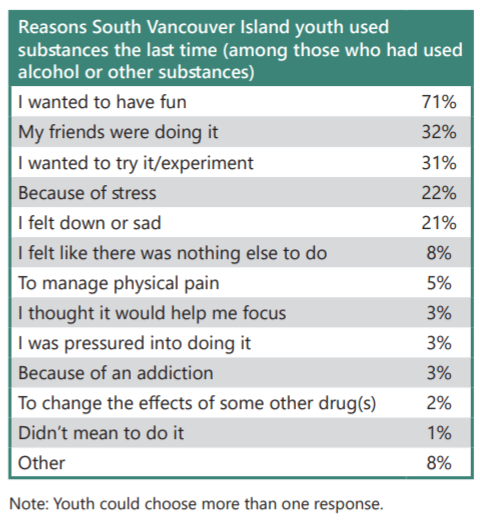
|
|
|
|
|
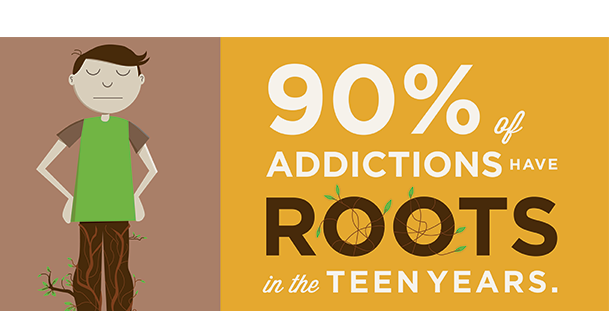
| The potential that drug use might lead to certain harms is influenced by several things:
More drug equals more risk. Increased risk is linked with a greater amount, more frequent use, and higher strength of a drug.
|
|
|
|
Younger age equals more risk. Drugs can influence the way brains develop. The younger a person is when they start using a drug regularly, the more likely they are to experience harm or develop problematic substance use later in life. |
Places, times and activities influence risk. Trying cannabis with friends at a weekend party and walking home later is less likely to result in harm than smoking cannabis on school property or driving under the influence.
|
| |
|
|
|
Vaping is the act of inhaling and exhaling the vapor produced by the heated nicotine liquid (often called “juice”) of an electronic cigarette (e-cigarette or e-cig), vape pen, or personal vaporizer. It’s also commonly called JUULing (pronounced jewel-ing).
Standard ingredients for e-cigarette liquid includes:
Nicotine - a chemical compound and an addictive stimulant that speeds up your blood pressure and heart rate.
|

|
|
|
Propylene glycol - a liquid additive that helps preserve moisture and flavor. E-cigarette manufacturers add it to the juice to help produce vapor when heated.
Glycerine - helps produce thicker vape clouds. It is usually mixed with propylene glycol to achieve a balance.
Benzoic acid - a food additive often used as a preservative.
|
|
|

| Although e-cigarettes have been around for more than a decade, vaping rates have skyrocketed in recent years, especially among teens. E-cigarettes are now the most frequently used tobacco product among adolescents — far surpassing traditional cigarettes.
|
|
|
|
|
|
 | There have been several deaths and hundreds of cases of lung illness attributed to vaping. It is unclear if the cause is bootleg cartridges containing THC or CBD oil from cannabis or legal nicotine cartridges. The CDC recommends that people avoid vaping entirely while this is being investigated.
Kids are also vaping cannabis at increasing rates, which brings its own health risks.
|
| |
|
|
|
|
|
Cannabis” is the scientific name for the hemp plant, and its leaves and flowers (often called marijuana) contain hundreds of chemical substances, and over 100 of these are known as cannabinoids.
THC is the most researched cannabinoid and is responsible for the way the brain and body respond to cannabis, including the high and intoxication. The potency of the THC in cannabis has increased from an average of 3% in the 1980’s to around 15% today.
|
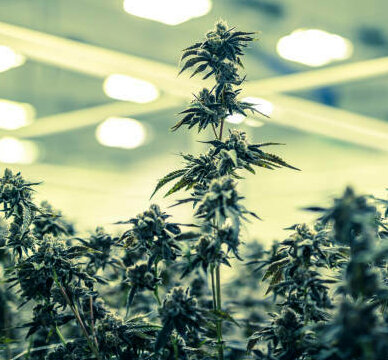
|
|
|
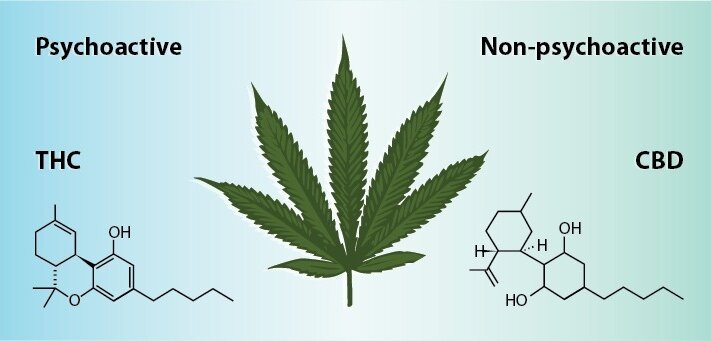
| CBD is another cannabinoid, and is responsible for many of the plant's physical effects and has been used to treat anxiety, pain, inflammation, insomnia, nausea and epilepsy.
|
|
|
There are two main cannabis species, sativa and indica. Sativa tends to have a more energizing and cerebral effect whereas indica tends to have more sedative and physical effects.
Effects can be felt within seconds to minutes of smoking, vaporizing or dabbing cannabis. These effects can last up to 24 hours. By ingesting or drinking cannabis, effects can occur within 30 minutes to 2 hours and last up to 24 hours.
|
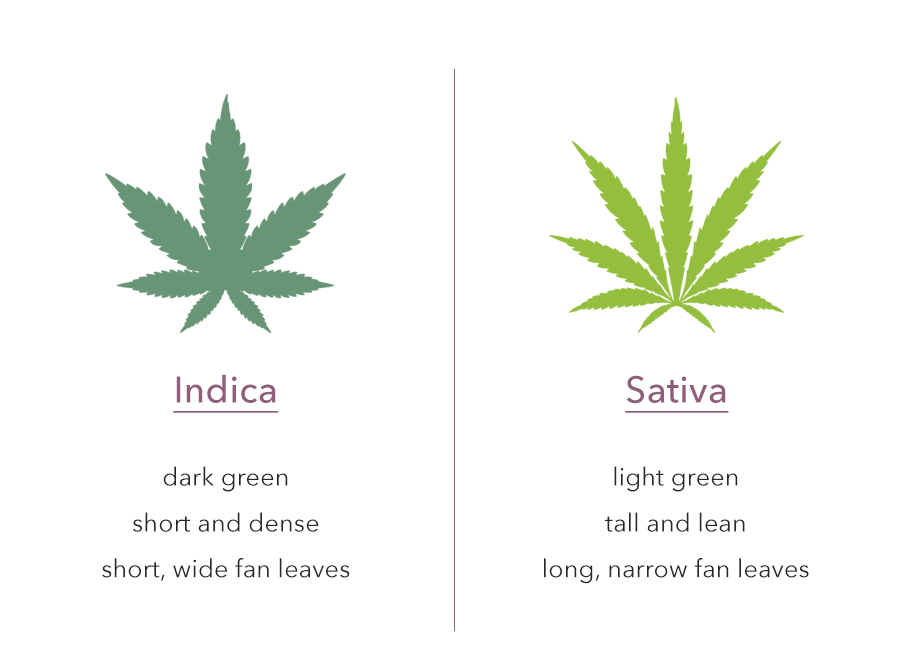
|
|
|
Short Term Effects Short term effects (often include): euphoria, sense of well-being, relaxation, heightened sensory experiences, confusion, sleepiness, impaired concentration, heightened anxiety.
Short term effects (may include): paranoia, delusions, hallucinations, increased heart rate, decreased blood pressure. | Long Term Effects Long term effects (develop gradually over time, with daily or weekly use that continues over weeks, months or years): increased risk of addiction, harm to memory, difficulties with concentration and ability to think and make decisions.
|
|
|
|
|
|
|
|
|
|
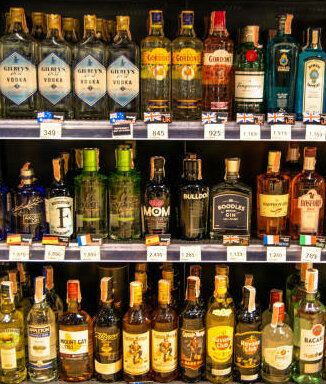
| Alcohol is the most common psychoactive* substance in Canada. It is made from grain, fruit or vegetables that are fermented and then used in beer, wine or liquor (vodka, rum, gin, etc.).
Alcohol is a "downer" or depressant. It slows down the central nervous system and makes a person think, talk and move at a slower pace. The effect alcohol has on a person depends on their size, ethnicity, drinking experience, mood and the environment it is used in. Usually, your body can process about one drink an hour. If you consume more, then you begin to become intoxicated.
|
| |
|
|
|
Binge drinking (defined as 4-5 drinks in a single sitting) and playing drinking games, both common among teens, cause blood alcohol content to rise to dangerous levels in a short amount of time. The liver has no time to catch up, which creates a backlog of alcohol in the blood stream. It is also important to note that drinking after the use of any kind of drug, prescribed or illicit, can increase the risks of alcohol poisoning.
|
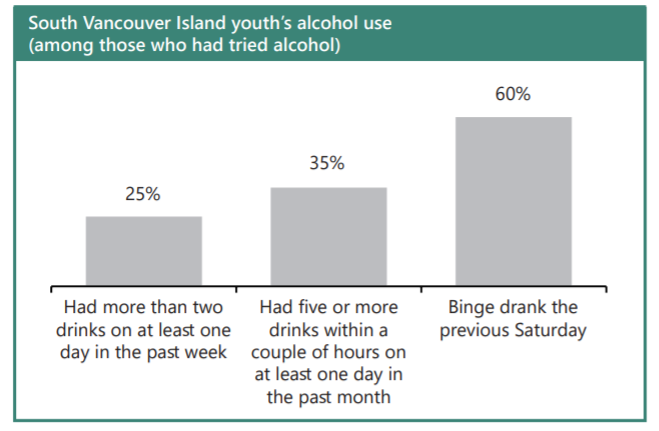
|
|
|
|
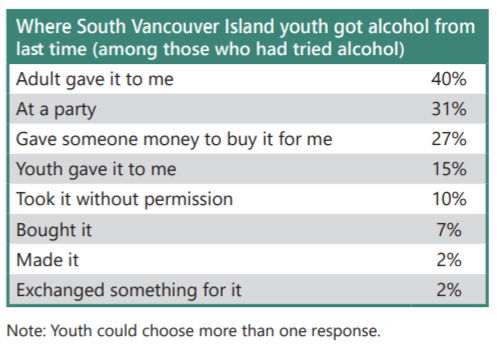
|
Teens are at a much higher risk of alcohol poisoning than adults because they metabolize alcohol less efficiently. Teens get drunk faster and stay drunk longer on less alcohol.
|
| |
|
|
|
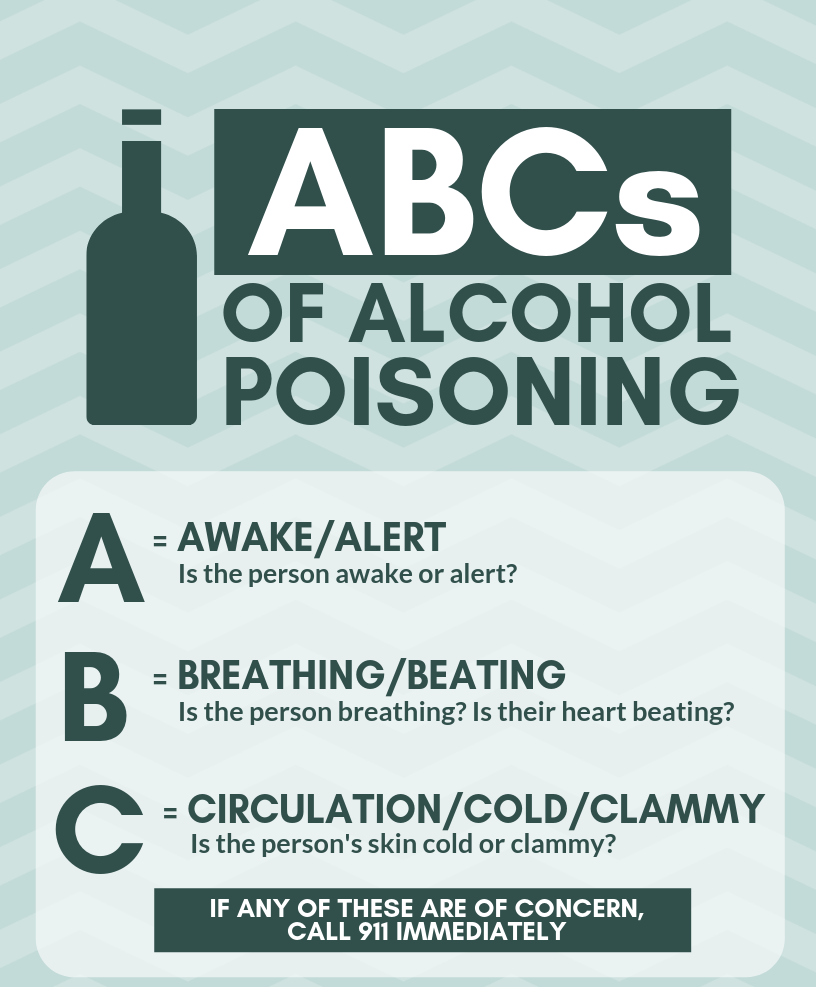
| Everyone should be aware of warning signs that indicate someone is suffering from alcohol poisoning. The first symptom is usually vomiting. This is the body’s attempt to protect itself by preventing any alcohol that remains in the stomach from being absorbed into the bloodstream.
Additional signs are as follows:
Unable to stand up or remain standing without assistance
Not responsive to talking or shouting or to physical contact like shaking or pinching
Clammy or cool skin, or bluish to purplish skin that appears very flushed
Slow irregular breathing and or pulse rate
|
|
|
It is recommended that parents review warning signs of alcohol poisoning with their teens and then have a conversation about safety. For example:
|
|
|
|

| “I expect you not to drink. But, I always want you to call me if you are in a risky situation. If you are in circumstances involving alcohol and someone needs help, you should call 911 first then me, or any other trusted adult. I would much rather you call for help than worry about being disciplined by me. There may indeed be a consequence if you personally have made some unhealthy choices, but my first concern is your safety. In the end, my response to the situation will be much tougher if you don’t call for help when it is needed.”
|
| |
|
|
|
|
|
|
|
Interesting and useful scientific facts about the developing adolescent brain - Dan Siegel
|
|
|
|
|
|
|
|
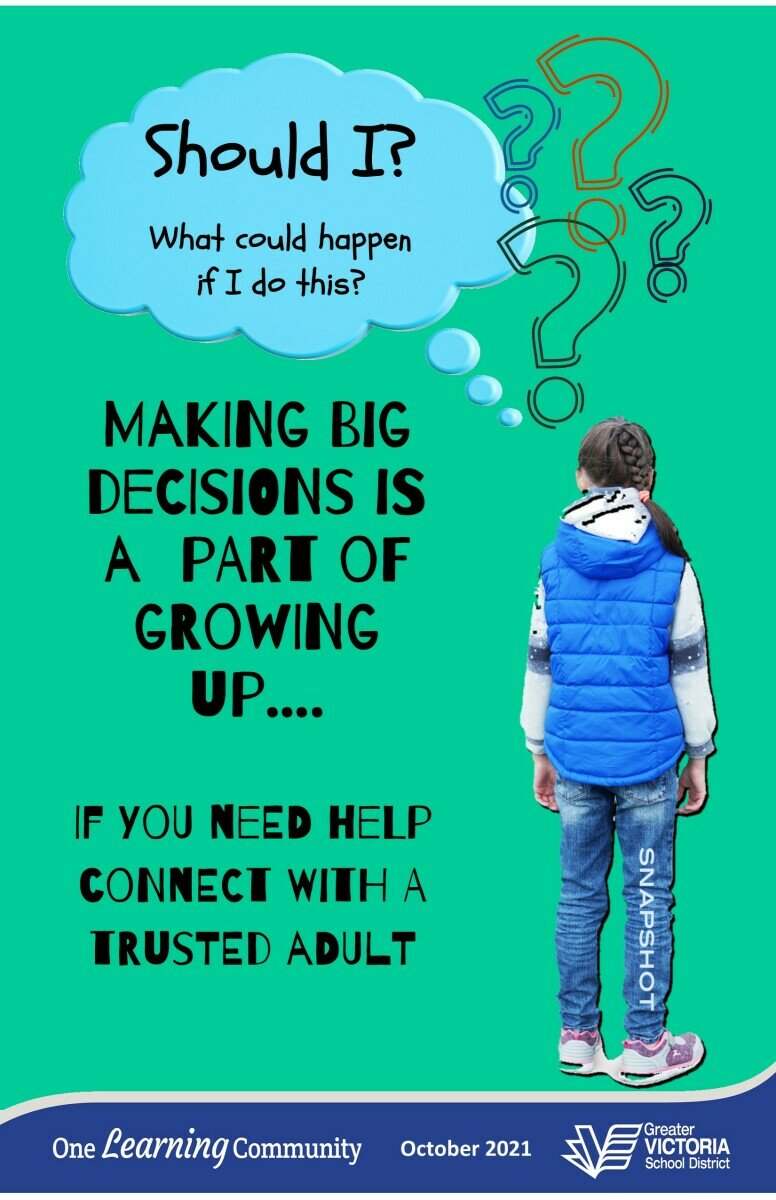
| Several copies of this poster have been delivered to all middle schools for student learning.
The poster acknowledges that students in middle school are making more and more decisions independently. It promotes responsible decision making by suggesting they consider the consequences of their actions. It encourages adolescents to seek help from a trusted adult who could guide them in the decision making process.
|
| |
|
|
|
|
|

|
Do you enjoy the monthly Snapshots?
Do you have suggestions on how to improve the Snapshots?
Do you have ideas for future topics?
Let us know!
We would love to hear from you!

|
|
|
|
|
|
|
|
|
|
|
|
|